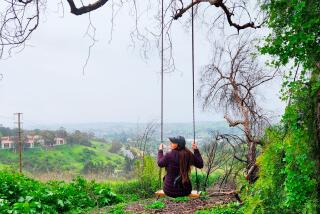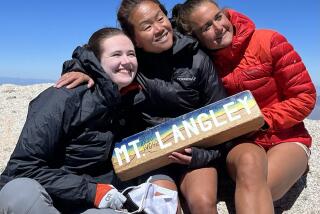For a terrific ride, relax and ‘let the horse run’
I didn’t come here to “bunny hop.” I just hoped I wouldn’t “biff.” (And if you want to know what I’m talking about, see the glossary on Page 6.)
I was here in Thousand Oaks to learn some technical biking skills from the guru of mountain biking in Southern California, Mark Langton.
The last time I rode a mountain bike, I went barreling down a mountain so fast I lost control and landed on a rock. My hip swelled up like a grapefruit and has been bumpy ever since. The crash put a chink in my armor of fearlessness. Seven years later, I decided it was time to get back on that iron horse and try again.
I signed up for a private lesson. Mountain biking includes some counterintuitive movements, but Langton promises on his website (www.mountainbikeskills.com) that a few minor adjustments in technique can put you back in control.
Langton booked me for two hours ($40 per hour), so we could work on some basic skills, then head into the hills for a short ride.
Bring a bike, he had told me, so I rented a dual suspension model and helmet from Europa Bicycle Center in Van Nuys ($40), bought a pair of biking gloves ($12.99) and dressed in layers.
Langton, 46, showed up dressed tip to toe in biking gear. His hair was bleached at the tips like a surfer’s, his quads and glutes were awe-inspiring. (What skills did I need to look like that? I wondered.)
The first thing I did was sign a document saying I understood I could be seriously injured -- or die. Then we spent 10 minutes on a bike overview. We checked tire pressure and adjusted the seat and handlebars to correct heights and angles.
“Never ride a bike from a department store before it has been checked by a bike shop,” he cautioned. “Often they are not built correctly.”
He had me climb on the bike and pedal up and down the street as he observed. He praised my stops and starts, and critiqued my body position.
“I call it going Homo sapiens,” he said. We walk upright and we want to ride upright, he explained. In mountain biking, he said, you always want to have your torso low, your elbows bent, ready to give and take.
Langton then told me the key to all I would learn next: relax. It is the hardest thing for a beginner to do.
From there we headed into the park. The lands of the Conejo Open Space Conservation Agency are a spectacular place to ride: some 15,000 acres with 75 miles of shared-use trails suitable for all levels of riders. Langton, who has lived in Southern California since the ‘60s, began riding Schwinn Stingrays in the hills of Agoura in 1969 and has been mountain biking since 1983. He raced for a couple of years and is ranked “expert” in downhill and cross-country. He knows these trails well and wrote a book called “Mountain Biking Santa Monica Mountains’ Best Trails,” a bible for serious bikers in the area. Once a month he teaches a free four-hour skills class for CORBA (Concerned Off-Road Bicyclists Assn.).
I wanted to learn new skills, but I also wanted to get a good workout. Mountain biking is an explosive workout compared with the long, steady push of road biking. Like road biking, it works the quads, calves and glutes, but because hill-bound cyclists use their upper bodies to control the bike, the sport also works your lats, shoulders, biceps and forearms.
We started with the position known from extreme biking videos: the “crouch.” The key is to keep your weight back so you don’t “endo” (fly over the handlebars). It’s like a balanced athletic position, Langton said. Like the stinkbug stance on a surfboard.
“Getting your body low is key for any kind of descent,” he said.
I stuck my butt in the air, pushed my thighs back against the seat, lowered my torso and bent my elbows. Zoom!
I rode up and down a tiny hill, up on the balls of my feet in “the crouch.” I was riding over dirt, stones, through grass, down steep hills. I could feel my corporate, office-bound, mother self peeling away like a skin. I was becoming a 12-year-old boy, riding wild in a big, big backyard.
Finally, Langton had me disappear in the grass and count to 30. As I flew down the hill again, he shot me on a tiny video camera he had concealed in his camel pack. He analyzed my position and had me look at it. Sure enough, my butt could get higher, my legs straighter.
It is all about letting the bike move underneath you as it needs to, Langton told me. “Let the horse run,” he likes to say.
He demonstrated by riding up a huge boulder and down the other side in a maneuver that seemed to leave him floating in midair at 90 degrees for a second, connected to the bike only by pedals and handlebars. The seat moved beneath him in the air. He did not invite me to try out my new skills on the boulder.
Next was braking. He had me ride down progressively steeper hills, applying the brakes gradually, to avoid slipping in the crumbly dirt. It’s a challenge. But I definitely felt I now had a skill that would allow me to go down almost anything. (Except that boulder.)
From there, we did climbing. My instinct was to get the hills over as quickly as possible, riding fast and hard. But on a mountain, that doesn’t get you very far, because you could be riding uphill for hours. Of course, you never stand up and pump the way you did as a kid on your old three-speed.
“If you try to pressure through,” said Langton, “you are going to burn yourself out.” Every bump and rock adds percentage to the grade, so it is important to conserve energy. It is important to shift gears early and often, he said. It is important to shift forward on your seat and lean into the hill. Then, pull down on your handlebars, and pump your upper body up and down. Don’t twist your torso and don’t weave back and forth, because on a narrow trail you could land in the underbrush.
At last, the moment I had been waiting for: We ditched the terrain area and headed deeper into the park so I could try out my new moves. Langton recommends 10 minutes of easy cycling, followed by basic stretches, before a real ride, but I was already warmed up.
The sun was setting, the rabbits were hopping through the bushes, the air smelled like sage. This, I think, is part of the addiction. We headed up a rutted hill strewn with rocks and mud. I felt daring, wild. With my new climbing skills I got to the top just fine, though by then I could barely breathe. Langton encouraged me to do the next hill more slowly.
From there we rode up, up, up. We stopped at a fork in the path and headed into a tunnel of green, around a corner, onto a narrow trail. I could feel the sweat tickling as it came out of my pores.
When we emerged we were halfway up the hill, with a vista of green hills spread out before us like a Dutch landscape painting. The sun was setting, and if I hadn’t felt lightheaded from the ascent, I would have been in heaven. “That’s the rest of the trail going up the hill,” Langton said, pointing to a trail that wound up the hill forever.
We rested, then turned around. I got into the “crouch” and let it rip. At least a beginner’s rip. We whooshed around corners and bumped over gravel and sand. (“Stay loose in the sand,” Langton yelled.)
We flew down a hill, then another, even steeper. I felt my body go stiff as I bounced down a rock-strewn path, but then I relaxed -- and it flowed.
We arrived at the gate near sunset. I tasted salt on my upper lip, and felt sweat trickling from under my helmet. I’d learned some cool skills, and gotten a taste of what a workout mountain biking could be.
After two hours, my lesson was over. But now I was really ready to ride.
*
(BEGIN TEXT OF INFOBOX)
Language of the trail
Want to up your cool quotient on the trail? Properly using the jargon is a key to mastering any sport, but especially mountain biking. Mark Langton has put together a glossary of terms on his website, which includes the lingo for obscure bike parts and strange types of compass readings. Here are a few excerpts:
Animal: Very aggressive rider; powerful hill climber
Biff: Crash
Bunny hop: A technical bike-handling maneuver that causes both tires to leave the ground, enabling the rider to jump obstacles, such as logs, rocks or fallen riders, without slowing down.
Bushwhack: To travel off the trail through heavy foliage. Also known as “lost.”
Endo: When the rear end of the bike comes up with the front wheel still on the ground to the point that it propels the rider over the handlebars.
Gram-aholic: A mountain biker who will buy the lightest part or component for [his or her] bike, even to the detriment of performance and safety.
Mulch: To completely destroy a bike’s component. As in, “I just mulched my derailleur.”
Poser: Has all the cool [bike] stuff, but doesn’t, or can’t, ride. Also known as “wannabe,” “dweeb” or “fred.”
Rookie mark: The big, gooey chain ring mark left on the right calf of less-coordinated riders.
-- Hilary MacGregor
*
Hilary MacGregor can be reached by e-mail at hilary.macgregor@latimes.com.
More to Read
Sign up for The Wild
We’ll help you find the best places to hike, bike and run, as well as the perfect silent spots for meditation and yoga.
You may occasionally receive promotional content from the Los Angeles Times.






